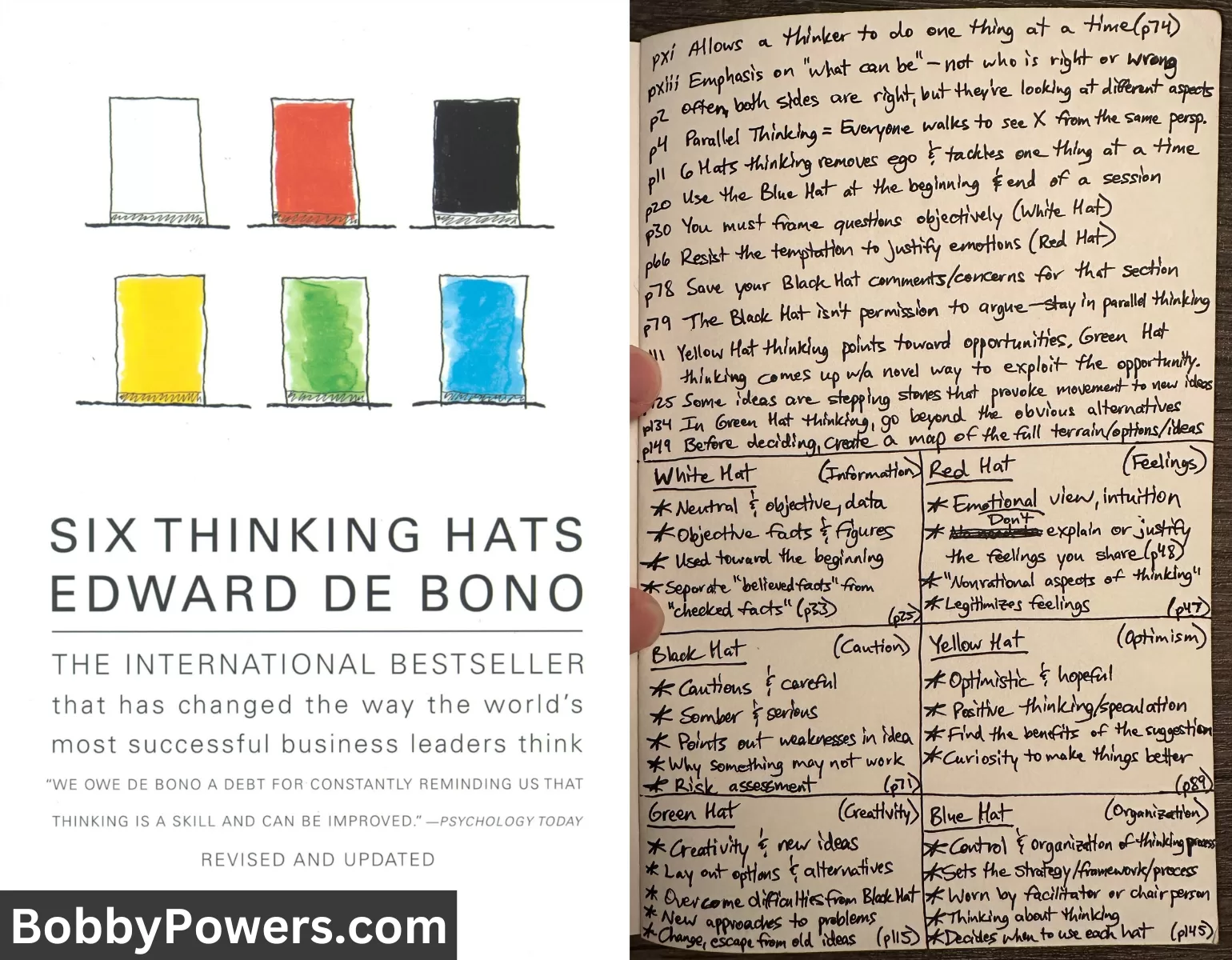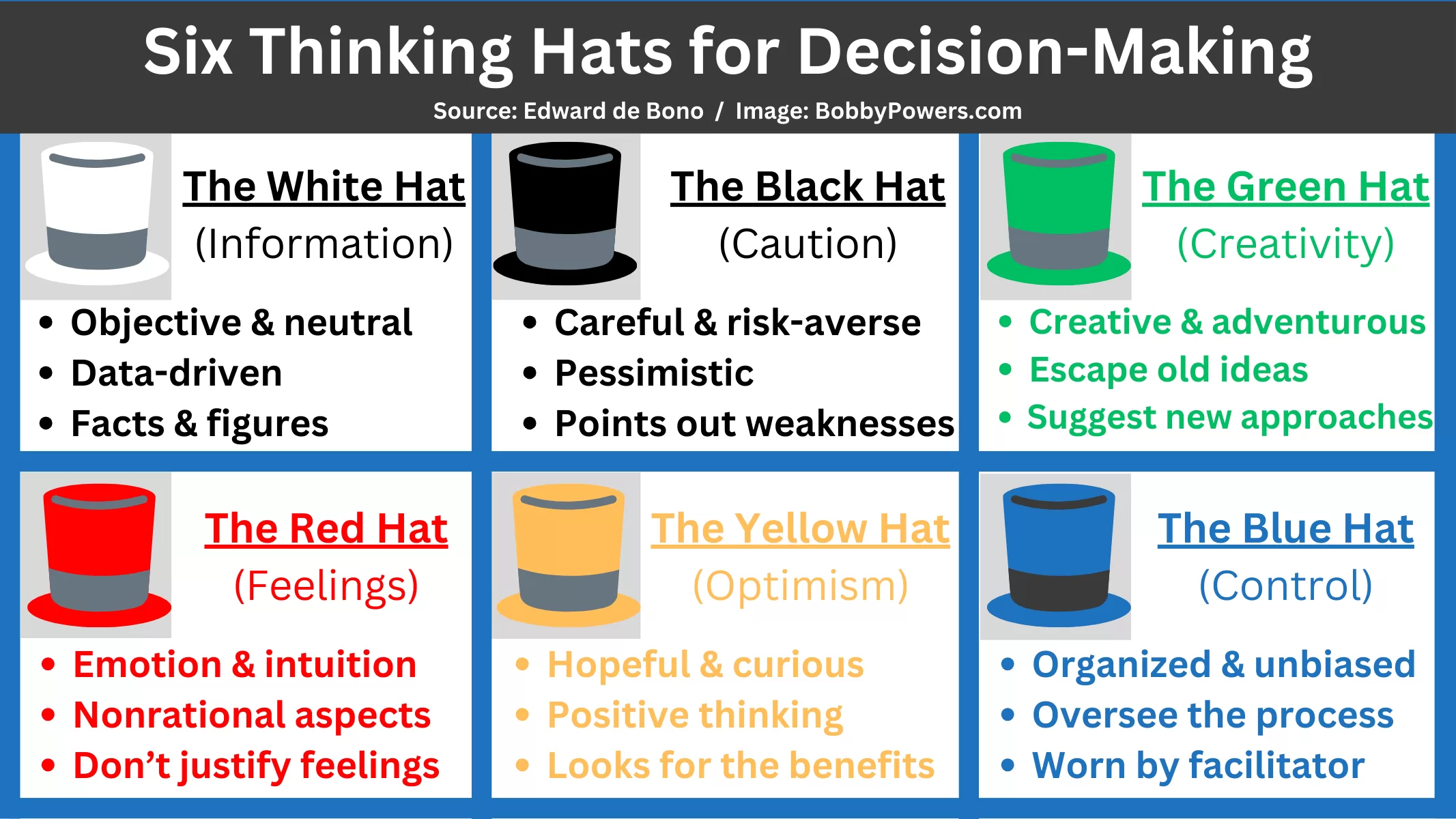Revolutionize Your Meetings with Edward de Bono’s ‘Six Thinking Hats’

A few months ago, I flew to Denver on a work trip and went out of my way to visit one of my favorite independent bookstores: Tattered Cover.
I beelined to the used books section in the basement and began perusing the nonfiction books (my favorite section). I snagged a few books, then stumbled upon a 1985 book about decision-making called Six Thinking Hats by Edward de Bono.
The book looked interesting and it was only seven bucks, so I added it to my stack. Turns out, I definitely got my money’s worth.
The book ended up being so good that I instantly added it to the list I’ve compiled of the books I’d require all company leaders to read if I start a business someday — including modern classics like Patrick Lencioni’s Death by Meeting, Cal Newport’s Deep Work, and Erin Meyer’s The Culture Map.
The Problem with Normal Meetings
Edward de Bono says we have a problem in Western culture: we focus too much on argument and debate when making decisions.
Rather than collectively viewing a problem from various perspectives, each person in a meeting chooses a side and digs in their heels. Then the discussion becomes a battle of willpower, ego, and one-upmanship instead of an honest search for the truth.
“It is so often the case in an argument that both sides are right but are looking at different aspects of the situation,” writes de Bono.
After studying decision-making and meetings for years, de Bono realized there must be a better way to facilitate meetings.
What Should We Do Instead?
Instead of each person campaigning for their idea, de Bono suggests that leaders should encourage their teams to use what he refers to as “parallel thinking”: everyone evaluates the decision from the same perspective at the same time.
“The essence of parallel thinking is that at any moment everyone is looking in the same direction—but the direction can be changed. An explorer might be asked to look north or to look east. Those are standard direction labels. So we need some direction labels for thinking.” -Edward de Bono
And the best direction labels, he says, are six different thinking hats — perspectives you can ask meeting attendees to “try on” to slowly evaluate a decision from multiple angles:
- The White Hat: Objective data, metrics, and information
- The Red Hat: Emotion, feelings, and intuition
- The Black Hat: Risks, cautions, and pessimism
- The Yellow Hat: Benefits, hopes, and optimism
- The Green Hat: Creativity, ideas, and new approaches
- The Blue Hat: Control, organization, and guidance*
*The meeting facilitator wears the Blue Hat. They keep everyone on track and decide when the group will switch hats to view the topic from a new perspective.
Using the six thinking hats model offers several upsides: minimizing ego, focusing the group on one topic at a time, aligning everyone toward a shared mission, pulling out the best ideas from everyone, and saving time.
de Bono has witnessed companies save hours and even days of time using this model compared to traditional argument-style models.

How to Use the Six Hats
“What I am putting forward in this book is a very simple concept which allows a thinker to do one thing at a time. He or she becomes able to separate emotion from logic, creativity from information, and so on…
The six thinking hats allow us to conduct our thinking as a conductor might lead an orchestra. We can call forth what we will.” -Edward de Bono
Here’s what the process would look like to facilitate a meeting using the six thinking hats:
- If a decision arises during a meeting, you’d ask attendees to approach the decision using the six hats. (Of course, they must first be familiar with this concept by reading the book together or digesting a summary such as this one.)
- As meeting facilitator, you wear the Blue Hat — determining how the decision should be made and when the group should put on each hat.
- Each other colored hat is one the group wears together to evaluate the decision from a parallel perspective.
- Other than beginning and ending with the Blue Hat (explaining the process you’ll follow, then recapping the group’s conclusion at the end), the sequence of hats can vary based on what type of decision the group is discussing.
Because the order of hats is subjective and can vary based on the situation, we won’t cover that topic in this brief review. But you can find more information about hat sequence here if you’re curious.
Tips for Facilitating Meetings with the Six Hats
Edward de Bono offers several tips for how meeting facilitators should use the six hats method:
- Do not choose one person to be something like the “Black Hat thinker” or “White Hat thinker” in a meeting. Everyone should put on each hat together. Doing so taps into the power of parallel thinking.
- Resist the temptation to classify someone as a specific hat, like “Ted is so negative. He’s a Black Hat person.” The hats are intended to describe modes of thinking — not individuals. Each hat comes with upsides and downsides, and each person should be able to wear every hat.
- However, if someone is disrespecting the rules and sharing ideas that don’t align with the group’s current hat, call them out on that behavior. That could sound like, “That sounds more like Black Hat thinking. Take off that hat for now. We need more Green Hat ideas first.” Or “Ted, save those emotions for the Red Hat section. For now, everyone needs to have on their White Hat to discuss the data and metrics we have at our disposal.”
- When the group is wearing the Red Hat (feelings), it’s important for participants to not justify their emotions. Justifications belong under the other hats — not the Red Hat. “We are brought up to apologize for emotions and feelings because they are not the stuff of logical thinking,” writes de Bono. “That is why we tend to treat them as an extension of logic…Red hat thinking frees us from such obligations.”
- Some people confuse the Yellow Hat (optimism) with the Green Hat (creativity). The difference is that Yellow Hat thinking points out opportunities within existing idea(s). Green Hat thinking generates novel ideas that go way beyond the existing or obvious alternatives.
My biggest takeaway from Six Thinking Hats was the overarching idea that decisions should be approached from multiple perspectives. This is something we all know in our gut, but de Bono offers a practical model for how to break down the components of a decision into their relevant parts.
I’m excited to apply these concepts to the meetings I lead. Of course, teams that collectively read this book together and utilize de Bono’s framework as a shared language will get the most benefit from this model. But even if your team never reads the book, understanding the six hats can help you lead better, more focused meetings in any organization.
Note: This post contains affiliate links. If you purchase a book, I’ll get a small commission at no cost to you.



